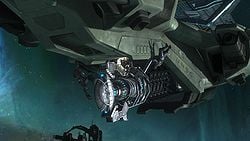Slipspace drive
From Halopedia, the Halo wiki
A Slipspace drive is a device designed to make transitions in and out of an alternate plane known as slipstream space, allowing faster-than-light travel.
Overview
A slipspace drive functions by creating ruptures between normal space and slipspace.[1] The nonstandard physics of slipspace allow it to be used as a shortcut realm, facilitating interstellar travel between distant regions in reasonable time.
A slipspace drive does not actually "accelerate" a spacecraft through slipstream space; this is performed by the ship's conventional reaction thrusters. Thus, ships with more powerful conventional engines are also faster within the slipstream.[2] As astrogation, the coordination of slipspace jumps, cannot be successfully done by a human, the calculations involved in a jump are done by a navigation computer or an AI.[3]
Human
- Main article: Shaw-Fujikawa Translight Engine
Developed in 2291 by the physicists Tobias Fleming Shaw and Wallace Fujikawa, the Shaw-Fujikawa Translight Engine generates ruptures by using high-power cyclic particle accelerators to generate microscopic black holes. The technology is still limited, however, and jumps typically take months or over half a year.
Covenant
Covenant slipspace drives, often referred to as "jump drives",[4] are capable of velocities far greater than human drives. In addition to their more powerful thruster engines, it has been theorized by the UNSC that Covenant drives generate several "microjumps" within a single slipspace transition to measure the dilation involved in a jump, allowing them to reach their destinations faster.[5] Instead of simply tearing a hole into Slipspace, Covenant slipspace drives cut a very fine hole in the fabric of space-time and slip into Slipspace with precision. It exits with the same pinpoint accuracy, takes less time during travel, and is able to plot a course with error not exceeding an atom.[6]
Forerunner
Forerunner understanding of the mechanics of slipspace far exceeded that of the UNSC or the Covenant. While little is know of the inner workings of Forerunner drives, they used "slipspace flakes" chipped from the Slipspace core, a crystal held in a location only known to the Master Builder.[7]
Sources
- ^ Halo: The Fall of Reach, page 141
- ^ Halo: Contact Harvest, Page 23
- ^ Halo: Contact Harvest, page 96
- ^ Halo: Contact Harvest, page 136
- ^ Halo: First Strike (2010), Tug o' War
- ^ Halo: First Strike, page 86
- ^ Halo: Cryptum, page 124
